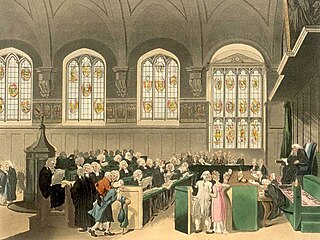The system of tort law in Australia is broadly similar to that in other common law countries. However, some divergences in approach have occurred as its independent legal system has developed.

A fiduciary is a person who holds a legal or ethical relationship of trust with one or more other parties. Typically, a fiduciary prudently takes care of money or other assets for another person. One party, for example, a corporate trust company or the trust department of a bank, acts in a fiduciary capacity to another party, who, for example, has entrusted funds to the fiduciary for safekeeping or investment. Likewise, financial advisers, financial planners, and asset managers, including managers of pension plans, endowments, and other tax-exempt assets, are considered fiduciaries under applicable statutes and laws. In a fiduciary relationship, one person, in a position of vulnerability, justifiably vests confidence, good faith, reliance, and trust in another whose aid, advice, or protection is sought in some matter. In such a relation, good conscience requires the fiduciary to act at all times for the sole benefit and interest of the one who trusts.
A fiduciary is someone who has undertaken to act for and on behalf of another in a particular matter in circumstances which give rise to a relationship of trust and confidence.
Australian constitutional law is the area of the law of Australia relating to the interpretation and application of the Constitution of Australia. Legal cases regarding Australian constitutional law are often handled by the High Court of Australia, the highest court in the Australian judicial system. Several major doctrines of Australian constitutional law have developed.

Frustration of purpose, in law, is a defense to enforcement of a contract. Frustration of purpose occurs when an unforeseen event undermines a party's principal purpose for entering into a contract such that the performance of the contract is radically different from performance of the contract that was originally contemplated by both parties, and both parties knew of the principal purpose at the time the contract was made. Despite frequently arising as a result of government action, any third party or even nature can frustrate a contracting party's primary purpose for entering into the contract. The concept is also called commercial frustration.

A collateral contract is usually a single term contract, made in consideration of the party for whose benefit the contract operates agreeing to enter into the principal or main contract, which sets out additional terms relating to the same subject matter as the main contract. For example, a collateral contract is formed when one party pays the other party a certain sum for entry into another contract. A collateral contract may be between one of the parties and a third party.

In trust law, an express trust is a trust created "in express terms, and usually in writing, as distinguished from one inferred by the law from the conduct or dealings of the parties." Property is transferred by a person to a transferee, who holds the property for the benefit of one or more persons, called beneficiaries. The trustee may distribute the property, or the income from that property, to the beneficiaries. Express trusts are frequently used in common law jurisdictions as methods of wealth preservation or enhancement.
Section 51(xx) of the Australian Constitution is a subsection of Section 51 of the Australian Constitution that gives the Commonwealth Parliament the power to legislate with respect to "foreign corporations, and trading or financial corporations formed within the limits of the Commonwealth". This power has become known as "the corporations power", the extent of which has been the subject of numerous judicial cases.
Section 51(xxxi) is a subclause of section 51 of the Constitution of Australia. It empowers the Commonwealth to make laws regarding the acquisition of property, but stipulates that such acquisitions must be on just (fair) terms. The terms is sometimes referred to in shorthand as the 'just terms' provision.
Australian property law, or property law in Australia, are laws that regulate and prioritise the rights, interests and responsibilities of individuals in relation to "things" (property). These things are forms of "property" or "rights" to possession or ownership of an object. Property law orders or prioritises rights and classifies property as either real and tangible, such as land, or intangible, such as the right of an author to their literary works or personal but tangible, such as a book or a pencil. The scope of what constitutes a thing capable of being classified as property and when an individual or body corporate gains priority of interest over a thing has in legal scholarship been heavily debated on a philosophical level.
In the criminal law of Australia, self-defence is a legal defence to a charge of causing injury or death in defence of the person or, to a limited extent, property, or a partial defence to murder if the degree of force used was excessive.

The law of contract in Australia is similar to other Anglo-American common law jurisdictions.
Quicquid plantatur solo, solo cedit is a legal Latin principle related to fixtures which means that something that is or becomes affixed to the land becomes part of the land; therefore, title to the fixture is a part of the land and passes with title to the land. Consequently, whosoever owns that piece of land will also own the things attached.
Australian trust law is the law of trusts as it is applied in Australia. It is derived from, and largely continues to follow English trust law, as modified by state and federal legislation. A number of unique features of Australian trust law arise from interactions with the Australian systems of company law, family law and taxation.

In law, an equitable interest is an "interest held by virtue of an equitable title or claimed on equitable grounds, such as the interest held by a trust beneficiary". The equitable interest is a right in equity that may be protected by an equitable remedy. This concept exists only in systems influenced by the common law tradition, such as New Zealand, England, Canada, Australia, and the United States.
Hyatt v. Vincennes Nat. Bank, 113 U.S. 408 (1885), was a case involving the sale of property conveyed to Hyatt for a term of 50 years for all the mineral coal upon and under a described tract of land, in Knox County, Indiana, with the exclusive right to enter on the land to dig for the coal, and remove it, and to occupy with constructions and buildings as needed to obtain the coal. Hyatt would then have the right to remove all buildings or fixtures placed on the land, when the agreement expired, and to pay a fixed royalty for the coal mined.

English land law is the law of real property in England and Wales. Because of its heavy historical and social significance, land is usually seen as the most important part of English property law. Ownership of land has its roots in the feudal system established by William the Conqueror after 1066, but is now mostly registered and sold on the real estate market. The modern law's sources derive from the old courts of common law and equity, and legislation such as the Law of Property Act 1925, the Settled Land Act 1925, the Land Charges Act 1972, the Trusts of Land and Appointment of Trustees Act 1996 and the Land Registration Act 2002. At its core, English land law involves the acquisition, content and priority of rights and obligations among people with interests in land. Having a property right in land, as opposed to a contractual or some other personal right, matters because it creates priority over other people's claims, particularly if the land is sold on, the possessor goes insolvent, or when claiming various remedies, like specific performance, in court.

Highway Properties Ltd v Kelly, Douglas and Co Ltd is a leading Canadian property law case concerning commercial landlord-tenant relationships decided by the Supreme Court of Canada.

Fairclough v Swan Brewery Co Ltd, is a land law case, in which the Privy Council held that restrictions on the right to redeem a mortgage are void. The equity of redemption means that borrowers are able to sell or obtain new mortgage finance promptly and without impinging on other dependent transactions.

New South Wales v Commonwealth, commonly known as the Wheat case, or more recently as the Inter-State Commission case, is a landmark Australian judgment of the High Court made in 1915 regarding judicial separation of power. It was also a leading case on the freedom of interstate trade and commerce that is guaranteed by section 92 of the Constitution.

Muschinski v Dodds, was a significant Australian court case, decided by the High Court of Australia on 6 December 1985. The case was part of a trend of High Court decisions to impose a constructive trust where it would be unconscionable for a legal owner of property to deny the beneficial interests of another. In this case the Court held it would be unconscionable for Mr Dodds to retain a half share of the property without first accounting for the purchase price paid by Ms Muschinski.







